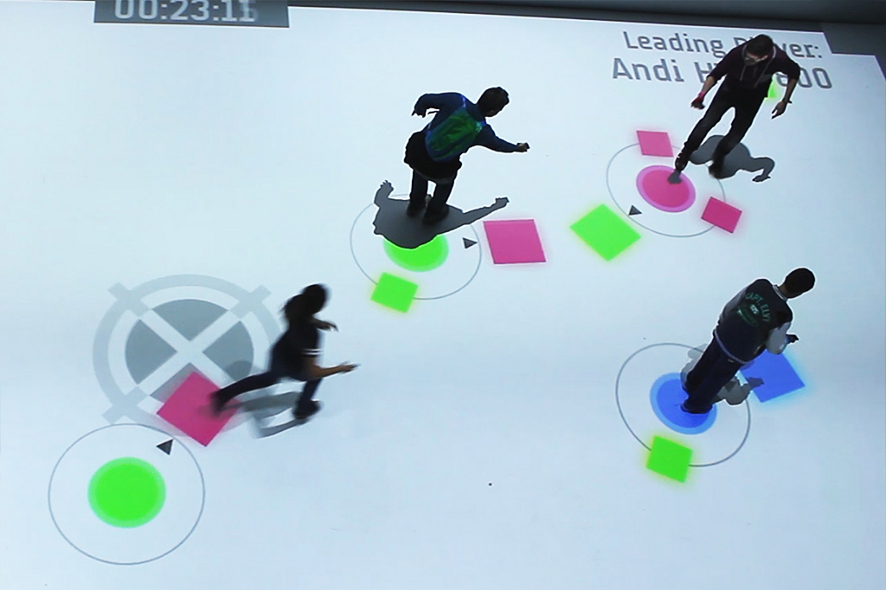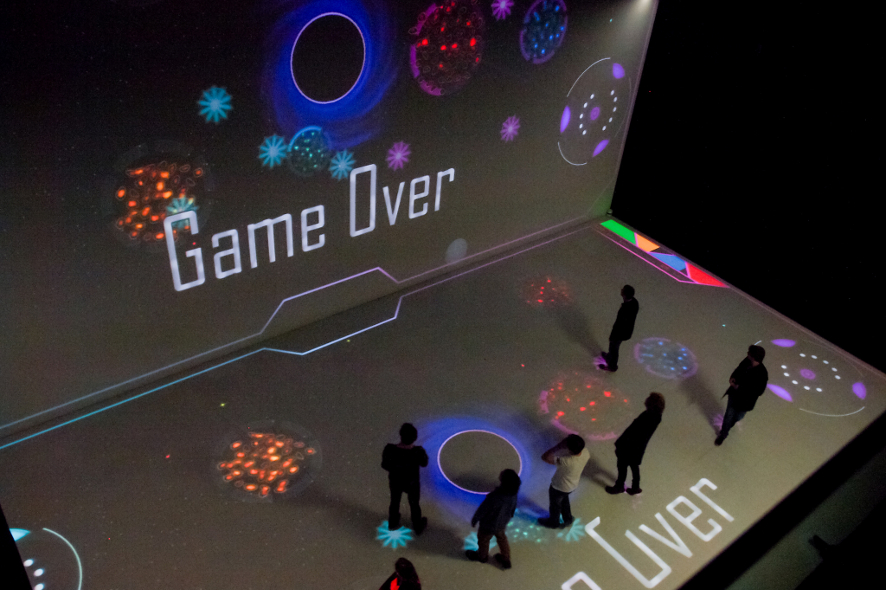Game Changer Suite is a collection of multiplayer games that were developed as prototypes by students at the Upper Austria University of Applied Sciences’ Hagenberg Campus. The accent in Game Changer is on exploring cooperative and competitive game playing. The gamers moving about in Deep Space 8K are registered by means of laser tracking, which enables them to control their virtual avatars projected onto the space’s wall and floor. Getting their whole body into the swing of things, they can play out a variety of scenarios—either collaboratively or every man for himself.
Jeremiah Diephuis, a faculty member at the Upper Austria University of Applied Sciences’ Hagenberg Campus, and Georgi Kostov and Andreas Friedl, recent graduates of the school’s Interactive Media master’s program, talk about the past and future challenges and possibilities of developing with the Game Changer Suite.
What led to the creation of Game Changer Suite?
Jeremiah: This was originally a project for the 2014 Festival, the theme of which was “C – What It Takes to Change,” so that explains both the title and the idea, as well as the concept of implementing competitive and cooperative approaches. I took my inspiration from games that amalgamate elements of various other games. I wanted to attempt to import familiar elements that people would recognize. Andreas, Georgi and the other members of the project group then input ideas of a very different nature – like Daniel Wilfinger and Poorya Pieroozan, both students of the Master’s Degree Programme Interactive Media. As a result, it really became a suite, a collection that lets players try out various types of games.
Andreas: What I find very interesting is that there are both competitive and cooperative games, as well as ones that are team-based and those in which it’s every man for himself. This all came together by chance, so the upshot was a colorful mixture of different mechanics and directions.
Are these games available only in Deep Space?
Jeremiah: They were developed especially for Deep Space, but now there’s talk of implementing them in other Ars Electronica installations—for instance, the recently opened Deep Space Theatre in Singapore.
And as of a couple of weeks ago, Hagenberg also features its own space with laser tracking and projections. Of course, it’s not as big as Deep Space and the quality isn’t as good either, but it offers us the possibility of developing and testing new stuff. We call it PIEspace since it’s for the new Playful Interactive Environments research group whose members have been strongly influenced by Deep Space projects.

What to play? Decide by your position. (Credit: Martin Hieslmair)
What’s your next move in developing the game collection?
Jeremiah: The Game Suite is designed to be expandable. The framework was developed in such a way that it’s relatively easy to add new games or replace existing ones. We’re constantly coming up with new ones; Andreas and Georgi created several games for their degree projects.
Andreas: The game that—following its launch at the Ars Electronica Festival and MUM—will be making its public debut on Sunday, December 20, 2015 is LazorLab. The idea was to give the players in this game environment more control over the game. GameChanger is a lot of fun and players get to more around a lot, but really the only point of a player’s position in space is to steer his/her avatar. The idea behind my degree project was to expand the interface between the player and the game by bringing the smartphone into play. In LazorLab, you connect your personal smartphone to the game, which gives you the possibility of performing several different types of interaction in the game and receiving feedback. This works when you’re playing alone as well as in a team.
Georgi: My project was to enhance Game Changer with an additional level, with virtual reality via Oculus Rift. I tested how they can be brought together and how people can use it to play together. The individual with the Oculus sits next to the playing field and has an overview of the whole game in the three-dimensional version, and that person gives information to the people on the playing field so they can coordinate their actions with each other and locate their opponents. They can carry out actions collaboratively, and this cooperation works really well. But we’re not presenting it to the general public just yet because it takes a certain amount of time for you to get used to Oculus Rift and then play the game in a satisfying, goal-oriented way.
Jeremiah: This is a challenge for most people—within the very brief timeframe of a presentation in Deep Space, to get the hang of the interaction and to comprehend the ways you have to move in order to be able to really interact with the other players.
Andreas: The primary focus of all our projects for Deep Space is to make the games as accessible as possible and to break down all the mechanics so the players can really enjoy the experience. And the game always has to be scalable—that is, it has to work just as well for four people as for 15.
Jeremiah: We’re currently working on offering interaction possibilities to the members of the audience—for example, enhancements that enable the players in the game to create an object that they can later use in real life. In Limelight, one of the previous games, players could generate resources for use in the game via SMS. Or, instead of objects, wind or gravity would also be conceivable. Thus, the interaction shouldn’t only be by means of position tracking; it should also be possible via network communication.

Use your mobile phone for participating LazorLab. (Foto: Marc Mühlberger)
What changes did the switchover to Deep Space 8K bring about for you? I mean, Game Changer Suite was one of the first projects that ran successfully in the new, upgraded Deep Space.
Jeremiah: : (laughs) A lot of work. We equipped Game Changer for higher resolution graphics. The difference is huge. Plus, the switchover to the new version of Unity, the development environment now being used, also changed several things with respect to the interface elements, which we then had to revise. We were absolutely delighted that the switchover went so well because, after all, we didn’t have much of an opportunity to test the new hardware environment. I really have to single out Andreas and Georgi for recognition—the semester was over, they had degree projects to write, but they nevertheless volunteered to continue working—for no monetary compensation—on the development of Game Changer over the summer so it really functioned perfectly at the opening.
Andreas: Right from the start, it was clear that this was something bigger than a semester project. You don’t often get the opportunity to create something for such a large live audience. And when we kept receiving positive feedback, we figured: Let’s just keep at it!
Jeremiah: Yeah, it’s simply a lot of fun—nowhere else in the world is there an environment like this. Students just starting out in our program usually want to create games that you would tend to categorize as commercial—for instance, 2-D real-time strategy games. So, if I say: C’mon, let’s create an art project, an installation, it’s very difficult for me to channel their energies in that direction. But once we get together in Deep Space and the students try out the game and see how well this laser tracking system functions, they get totally enthused and there’s no need to try to talk them into it anymore. I’d like to take this opportunity to thank the Ars Electronica Futurelab and especially Otto Naderer for having developed this system and given us access to it. Otto is always available when we need support in working with the laser tracking.
What effect does Deep Space’s new technology have on the gaming experience?
Georgi: For one thing, of course, the resolution. But there’s also the enormous luminosity, the contrast is much greater, and the colors are far more intense. That makes a big difference.
Andreas: At the Festival, LazorLab was given a very minimalistic design—white background, glowing forms. Now, with the new projectors, it’s almost overexposed. This is something you’re totally unaccustomed to—that you have to hold back a little with the use of color!
Jeremiah: Now that we’ve seen the 3-D capabilities that are available—above all with respect to the floor projections—it’s almost enough to make you want to get to work on stereoscopic applications. This has been a dramatic technological shift. We’re very much looking forward to doing more.

Credit: Martin Hieslmair
Why did you restrict yourselves to 2-D applications up to now?
Jeremiah: Although many games are floor-oriented, most people look at the wall. However, you can’t lose sight of the fact that there are lots of people who are a bit standoffish at first about taking part, though they’d like to watch but the distances to the screen vary too much. You can configure the 3-D perspective only for a particular area, so that only a few people in the space have a really good view. Furthermore, stereoscopic applications are, of course, much more elaborate and time-consuming. We have a small crew and no graphic artist, so we would definitely need more help.
Andreas: And you would also need a clever game concept in which this would make sense. Not 3-D simply for the sake of having 3-D; there should also really be something behind it.
Jeremiah: Now we have an idea for a labyrinth game in which the floor is the plate whose orientation the players collaboratively shift by changing their position and thereby steer a ball through the labyrinth. We devote a lot of time and energy to thinking about stuff like this …
You’re invited play along during the “Spielräume” [PlaySpaces] weekend in Deep Space on Saturday & Saturday, December 19-20, 2015 at 12:30 and 3:30 PM both days, as well as at 5:30 PM Saturday.
On Sunday, December 20, 2015 at 3 PM, Jeremiah Diephuis will personally present Game Changer Suite.

Jeremiah Diephuis has been an instructor in the Media Technology & Design and Interactive Media programs at the Upper Austria University of Applied Sciences’ Hagenberg Campus for many years. For the last three years, he and his colleagues have developed various game projects for Deep Space at the Ars Electronica Center.
Georgi Kostov is a graduate of the Interactive Media program. He’s currently on the staff of Hagenberg’s new Playful Interactive Environments research group.
Andreas Friedl also studied Interactive Media at Hagenberg and recently completed his work on his master’s degree, a game project for Deep Space 8K.
